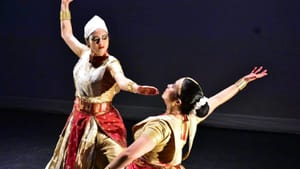Stay in the Loop
BSR publishes on a weekly schedule, with an email newsletter every Wednesday and Thursday morning. There’s no paywall, and subscribing is always free.
More than practice
The Courtyard Dancers Facing East festival presents ‘Riyaaz’ at FringeArts

Riyaaz, the program notes told us, means “practice.” Honing one’s craft is at the center of practice, but it means more than that. Those who saw the medley of performances from the Courtyard Dancers 2019 Facing East festival at FringeArts, featuring four different branches of Indian dance traditions in a show titled Riyaaz, have a new understanding of practice.
Practice is the process of stripping away the inessential to connect more deeply with dance, the world, and the community. Riyaaz can be painful—with callouses like jewels on the feet, the voiced narration said—but in the paradoxical nature of meaning-laden practice, the dancer can disappear into the movement, leaving the world and its pain as the dance absorbs them.
For Facing East’s Riyaaz, four companies from four different practices of Indian dance joined in an evening that blended classic traditions with modern interpretations, some more successfully than others. Most of the companies had a diverse group of dancers and the evening included an ASL translator for the announcements and moments of interstitial poetry and commentary.
Rhythm and gesture
The evening opened with Courtyard’s Riyaaz, which echoed both the title of the show and its meaning, almost a lesson in the Kathak form. Dancers of the company in red flowing dresses, black leggings, and bells at their ankles stamped their feet and moved their hands in classic movements. Artistic director Pallabi Chakravorty sat at the side of the stage, next to percussionist Aqeel Bhatti, and sang out the syllables that marked the patterns of rhythmic beats and gestures. Later, in a piece called “Tarana,” the company, dressed in black with gold trim and ankle bells, left no doubt about flamenco’s roots in the ancient forms of India.
Mudras, movement, and misting up
The Sattriya Dance Company presented the Sattriya form, a dance performed by monks in northern India and only recently permitted to women. Dancers Madhusmita Bora, in a gold dress with red waistcloth, and Prerona Bhuyan, in gold dhoti pants, could have sprung from the walls of a temple. They told their story in broad dance moves and facial mime, with precise hand gestures called mudras. They delighted every time they took to the stage.
Of the four companies, Sakshi Productions succeeded best at delivering a modern aesthetic with a socially conscious message that both entertained and made us think. The company’s artistic director, Nandini Sikand, choreographed and performed “DAM/AGE” with her sons Manav and Armaan Sikand Thompson. The piece used words, dance, and pictures (stick drawings by Manav Sikand Thompson projected on a screen behind the action) to explore the pain of abuse passed down from generation to generation. In a recurring motif, Nandini Sikand lies on her back on the floor, curls around herself with her legs held half-bent in the air, evoking a fetal rejection of pain. At the end of the piece, she echoes the same pose, this time with the arms of her eldest son around her. It makes me a bit misty just to recount it.
Another piece, “Gestures of Longing,” combined Indian mudras and American Sign Language in a dance performed in silence, while the words of Linwood Smith’s “The Dream Song of the Deaf Man” floated across the background screen. Snippets of the poem were inserted in our programs, bringing us into the performance before it had even begun.
A springtime story
I really wanted to love Dakshina/Daniel Phoenix Singh Dance Company. It told a mythic story of a sleeping Shiva and the hope of spring with enough spoken word that we could follow the action. The blue and green costumes evoked the springtime of the story, and some moments were lovely, as when the seeds of love were gathered and arrows of love shot at the Shiva sitting in repose at the corner of the stage. But in general, the balance of modern dance to classical Bhatara Natyam style didn’t quite work. The piece, presented in two parts widely separated in the program, felt overlong, and not all the dancers were up to the challenge. A special shout-out for Rachel Prem, however: she was utterly convincing, her mudras precise and graceful. I could have watched her all night.
What, When, Where
Riyaaz. Presented by Courtyard Dancers. October 11 and 12, 2019 at FringeArts, 140 N. Columbus Boulevard, Philadelphia. courtyarddancers.org.
FringeArts is an ADA-compliant venue. For information on all accessibility features, visit here, call the box office, or email [email protected]. There is a private gender-neutral restroom available on the second floor.
Sign up for our newsletter
All of the week's new articles, all in one place. Sign up for the free weekly BSR newsletters, and don't miss a conversation.

 Camille Bacon-Smith
Camille Bacon-Smith